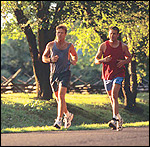 |
|
Iron Overload and Hemochromatosis: Self-Care Tips |
|
 There is much you can do to make sure your life is as normal and
healthy as possible. There is much you can do to make sure your life is as normal and
healthy as possible.
- Check-ups: Have the amount of iron in your blood checked regularly.
- Phlebotomy: Make sure to get phlebotomies when you need them.
- Iron pills: Don’t take iron pills, supplements, or multivitamin
supplements that have iron in them. Eating foods that contain iron is
fine.
- Vitamin C: Vitamin C increases the amount of iron your body absorbs.
Avoid taking pills with more than 500 mg of vitamin C per day. Eating
foods with vitamin C (such as oranges) is fine.
- Food: Don’t eat raw fish or raw shellfish. Cooking destroys germs
harmful to people with hemochromatosis. People with hemochromatosis are at
greater risk for bacteremia, a bacterial infection of the blood stream.
- Alcohol: If you choose to drink alcohol, drink very little. Women
should have no more than one drink a day. Men should have no more than two
drinks a day. However, if you have liver damage, do not drink any alcohol.
- Exercise: You can exercise as much as you want. The CDC and the
American College of Sports Medicine offers the following physical activity
recommendations:
- Adults should engage in moderate-intensity physical activities
(indicated by some increase in breathing or heart rate) for at least 30
minutes on most preferably all days of the week.
|
Key Point |
| Phlebotomy is the best treatment
for hemochromatosis. Hemochromatosis cannot be treated by
changing your diet alone. |
back to top
|
 |
|